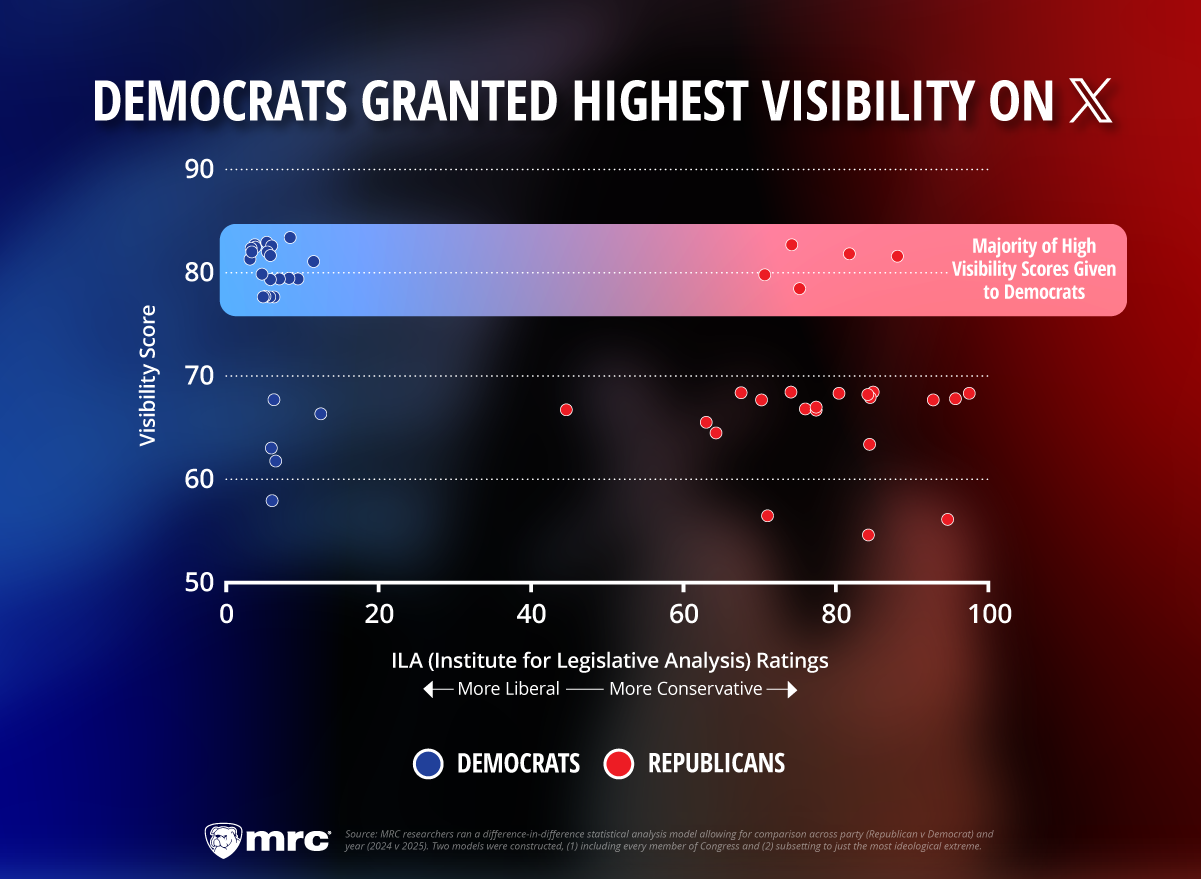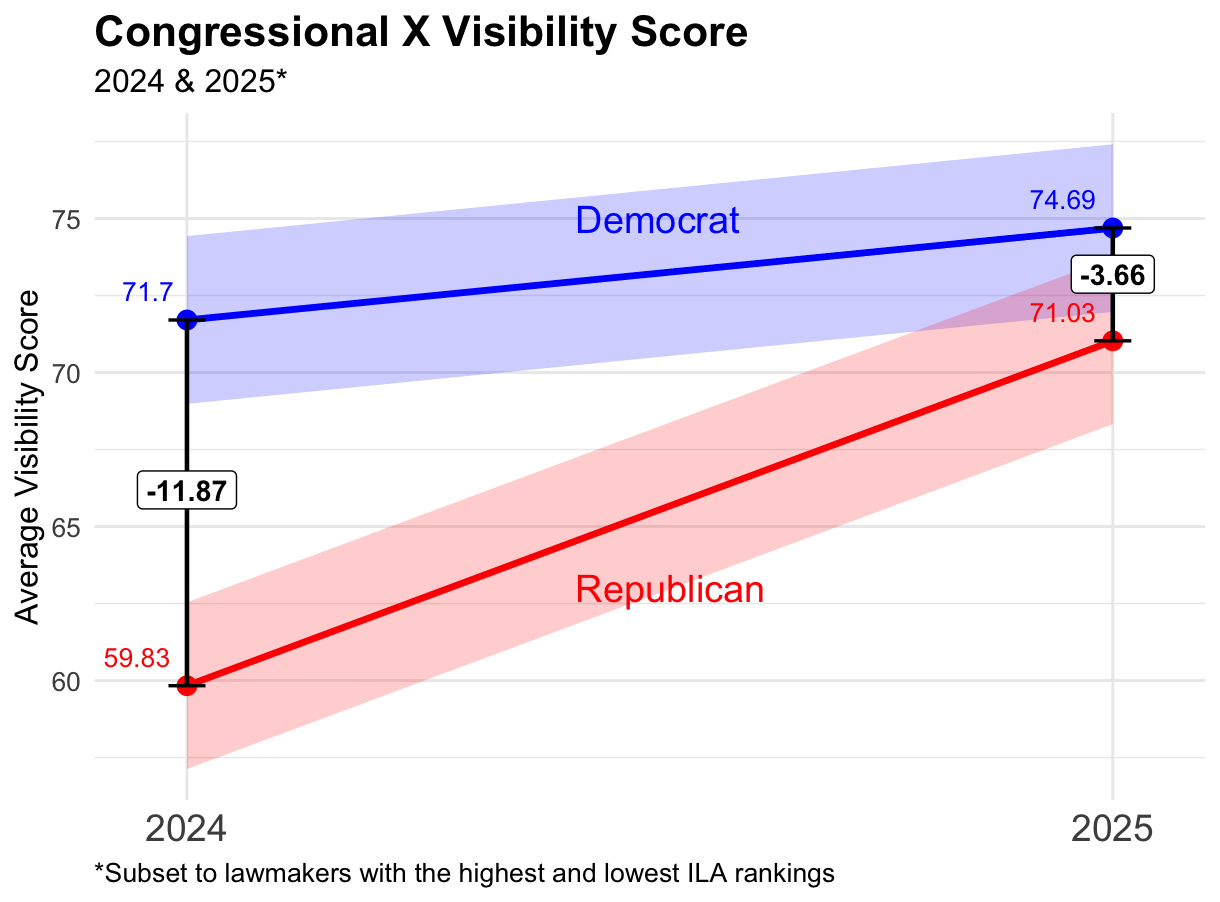 X owner Elon Musk can no longer hide behind predecessor Jack Dorsey and the radical programmers who have remained with the company since its change of ownership. Nearly three years after Musk bought Twitter (now X), the platform still favors liberals over conservatives, boosting voices on the left at the expense of account holders on the right. And this includes the accounts of members of Congress.
X owner Elon Musk can no longer hide behind predecessor Jack Dorsey and the radical programmers who have remained with the company since its change of ownership. Nearly three years after Musk bought Twitter (now X), the platform still favors liberals over conservatives, boosting voices on the left at the expense of account holders on the right. And this includes the accounts of members of Congress.
Democrats are the clear winners in the X sweepstakes, especially the most extreme members of Congress, like Senators Mazie Hirono (D-HI), Adam Schiff (D-CA), Chuck Schumer (D-NY) and Raphael Warnock (D-GA); and Representatives Alexandria Ocasio-Cortez (D-NY), Nancy Pelosi (D-CA), Rashida Tlaib (D-MI), and Maxine Waters (D-CA).
X assigns “visibility scores” to each of its account holders. These scores determine the degree to which posts are either amplified or suppressed. In the U.S. House, the highest visibility scores heavily favor Democrats, with 20 of 25 of the best scores belonging to the most radical members of Congress. Conversely, 20 of 25 of the lowest scores are assigned to Republicans, effectively resulting in the deboosting of their posts.

Similarly biased results (though slightly less drastic) played out in the Senate. X assigned 16 of 25 of the highest visibility scores to Democrats and 18 of 25 of the lowest visibility scores to Republicans.
With the 2026 midterm elections in sight, and the parties seeking every tactical advantage in light of razor-thin margins in both chambers of Congress, the significance of X tipping the scales in favor of Democrats could be monumental. It could mean the difference between President Donald Trump being impeached by House Democrats a third time versus the president achieving additional legislative victories in his final two years in office.
A new MRC analysis found that X still boosts the congressional accounts of Democrats more than those of their Republican colleagues. Last year, MRC researchers ran a similar analysis to determine the levels of partisan suppression on the social media platform. While the gap between Democrats and Republicans has shrunk since last year, indicating positive change is possible, lingering differences remain.
Following the methodology of last year’s study, MRC researchers prompted Grok to calculate four measurements that affect the likelihood of one’s content to be recommended to others. The “visibility” score is an index of four variables— diversity of followers, purported reliability, follower retention and account toxicity — on a scale of 0-100 (a system initially discovered by @The1Parzival). Ostensibly, the purpose of this visibility score is to amplify posts deemed to be more trustworthy and less extreme, as determined by X’s algorithm as overseen by the employees at the company.
However, outlandish posts made by Democrats with high visibility scores on X underscore the glaring disparity between how X treats politicians across the ideological spectrum.
X Gave Far Better Visibility Scores to House Democrats Than House Republicans.
X gave some of the most radical and hyperbolic Democrats some of the best visibility scores, compared to their Republican counterparts.
Infamous bartender Rep. Alexandria Ocasio-Cortez (AOC) captured the sixth highest visibility score among members of the House. Notwithstanding her high ranking, she made numerous outrageous posts on X, which seemingly did not harm her visibility score. In one post, AOC wrote that “pregnant people are being PUSHED TO DEATH’S DOOR due to delayed access to abortions,” managing to mix the woke gender ideology that men can become pregnant while fearmongering against protecting the unborn. Continuing in the attached video, she explained how Republicans cannot possibly be pro-life since they do not support “universal healthcare” and do not believe in “life after birth.”
AOC reiterated her point when she claimed that “women [are] dying because they can’t get basic healthcare” in a post from June of this year. She likewise expressed abhorrence at the idea of defunding Planned Parenthood, likening it to denying all American women healthcare generally. She also foolishly asserted an election integrity measure — targeted at ensuring only citizens vote — would disenfranchise all married women in America.
🚨House Republicans just passed a bill that would disenfranchise 70 million married American women.
Under the SAVE Act, women who took their spouse’s last name and don’t have an updated passport or birth certificate would be turned away at the polls.
— Rep. Alexandria Ocasio-Cortez (@RepAOC) April 10, 2025
Not to be outmatched by her “democratic socialist” colleague — and boasting the 11th highest House visibility score — ultra-partisan Rep. Waters ranted profusely about how the “MAGA-controlled Supreme Court” would permit Trump to “be the dictator he has threatened to be if elected.” In the same post, Waters asserted that because of the U.S. Supreme Court, “President Trump could legally commit murder if it’s determined it’s done in his official capacity,” a gross mischaracterization of the decision that affirmed Trump’s immunity in cases of “official acts” as president following months of extensive liberal lawfare. In another post on the same topic, she asserted Trump was a “fascist” who has routinely expressed “his love for Putin and Kim Jong Un” and “overall admired Hitler.”
Today, the MAGA-controlled Supreme Court issued a dangerous decision that would allow Trump to be the dictator he has threatened to be if elected. The Court’s decision to give a president immunity for official acts means that, if elected, Trump—who said he could shoot someone on…
— Maxine Waters (@RepMaxineWaters) July 1, 2024
Waters also took the chance to not only smear Trump, but also U.S. Supreme Court Justice Clarence Thomas. In a 2023 post, she implied that Thomas was a shill for “his billionaire, conservative friends” that “struck a blow against children of color” all because the U.S. Supreme Court ended racial discrimination via “affirmative action” in university acceptance practices.
Former Speaker Pelosi apparently didn’t want to miss out on the fun — as she boasted the second highest visibility score in the House — and decided to repeatedly play the racism card, among other absurd musings. Pelosi alleged that reforming voting laws to ensure free and fair elections was “the most sinister assault on the vote since Jim Crow.”
Right now, our nation faces the most sinister assault on the vote since Jim Crow.
MAGA legislators across the country are passing laws that seek not only to restrict access to the ballot, but also promote the nullification of election results with which they disagree.
— Nancy Pelosi (@SpeakerPelosi) July 20, 2023
“Squad” member Tlaib used her account (13th in the House) to call Israeli Prime Minister Benjamin Netanyahu a “genocidal war criminal” while berating President Trump for meeting with him and “openly calling for ethnic cleansing.” Tlaib also lambasted the U.S. Supreme Court’s June decision in United States v. Skrmetti — which protected children from dangerous, irreversible transgender surgeries — claiming that “gender-affirming health care for transgender young people is suicide prevention.” She even uploaded a video of herself on the floor of the House spouting the myth that “[women’s] bodies are now more regulated than guns in our country.”
One in three women are now living without access to abortion care. Our bodies are now more regulated than guns in our country. It’s disgusting.
MAGA extremists are pushing for a national abortion ban. We must fight back and protect our bodily autonomy. pic.twitter.com/nCEaQCeyEd
— Congresswoman Rashida Tlaib (@RepRashida) July 12, 2024
Although various hardline liberals benefited from higher visibility scores, the same can not be said for Republicans — even recipients of the MRC’s Free Speech Awards. Among those who received the award in 2024, Rep. Harriet Hageman (R-WY) ranked 183rd, Rep. Dan Bishop (R-NC) 206th, Rep. Tom Cole (R-OK) 273rd and Rep. Rich McCormick (R-GA) came in at 280th of the 363 available members of the House that MRC researchers analyzed.
X Also Assigned Better Visibility Scores to Senate Democrats.
Similar results spilled over into the Senate, though with less glaring disparity than seen in the House.
Sen. Warnock flaunted the fifth highest account visibility score despite incendiary X posts. Warnock repeatedly accused Republicans backing voter reform of racism, claiming they wanted to dress “Jim Crow in new clothes,” and scourged Republicans as “authoritarian,” “unsafe” and “un-American.” Warnock regularly stated he “stand[s]” with the left’s so-called transgender community and adamantly supported former President Joe Biden’s action to reinstate “transgender Americans to openly serve in the military,” lamenting that “[t]here is no such thing as equality for some.”
Instead of adjusting their message, some Georgia politicians have decided to rewrite the rules with SB 202—a thinly-veiled attempt to suppress the vote. It’s Jim Crow in new clothes.
We will not go back. And Congress must act to protect the sacred right to vote.
— Senator Reverend Raphael Warnock (@SenatorWarnock) March 26, 2021
Sen. Schiff paraded the Senate’s 17th highest visibility score, which he used extensively to malign Trump as a “dictator,” backed by accusations of fearmongering, saber-rattling, lawfare and “extortion” straight from the “dictator’s handbook.”
First, Donald Trump used the Marines and the National Guard to support his mass deportation agenda in Los Angeles.
Now, he’s using similar tactics in D.C. like a tinpot dictator.
Don’t look away. Don’t stay silent. If you do, don’t be surprised if it’s your city next.
— Adam Schiff (@SenAdamSchiff) August 11, 2025
Sen. Schumer lauded the eighth highest score among fellow Senators while similarly denouncing Trump as a “dictator.” He also falsely accused the Trump administration of racist practices, claiming he incited a fear among young New Yorkers of “being rounded up on the streets and sent to a prison in Louisiana because of the way they look.”
When our founders drafted the Constitution, they feared precisely a man like Donald Trump.
He is acting like a king.
A despot.
A wannabe-dictator.— Chuck Schumer (@SenSchumer) April 29, 2025
Sen. Dick Durbin (D-IL) also benefitted from increased visibility, touting the ninth highest score despite spreading misinformation about deportation efforts and defending Hamas-sympathizer Mahmoud Khalil. Durbin threw national security concerns and objective biological truth out the window to support “transgender migrants & asylum seekers [who] are uniquely vulnerable while in immigration detention centers” and even emphasized the need to “protect” and “stand with” transgender youth.
We need to keep fighting to protect LGBTQ Americans, especially transgender youth.
— Senator Dick Durbin (@SenatorDurbin) February 8, 2023
Not to be outdone, Sen. Hirono holds a visibility score in the top third of her Senate colleagues (19th) and yet, used her account to blister and badmouth MAGA Republicans as autocratic. She similarly waged a war against science, supporting so-called “trans women” (biological men) in women’s sports. Hirono claimed that “if Republicans were actually worried about girls in athletics, they would join in our efforts to address unequal athletic opportunities in school, unequal pay, sexual abuse and harrasment and more,” presenting her argument that protecting women through DEI policies would be more beneficial than removing biological men from their locker rooms. Hirono argued vehemently in favor of killing the unborn, outrageously denouncing pro-lifers for daring to save the lives of children and lashing out at what she dubbed “Trump’s far-right SCOTUS” for overturning the left’s sacred cow, Roe v. Wade.
I just blocked @SenateGOP from advancing harmful, hateful legislation to ban trans women & girls from participating in sports consistent with their gender.
This isn’t about supporting women & girls, it’s about discrimination. pic.twitter.com/5jGbgQfFey
— Senator Mazie Hirono (@maziehirono) June 23, 2022
One of the lowest visibility scores among senators (79th) belongs to Sen. Eric Schmitt (R-MO), an avid promoter of free speech, and a recipient of MRC’s annual Free Speech Awards. On his X account, Schmitt has regularly defended American freedoms by calling out partisan hypocrisy in regard to free speech and defending the X platform from financial attacks from the European Union over “disinformation.” His reward for defending Americans: a deboosted account.
VP @JDVance delivered the exact right message here in Munich.
Free Speech Now.
Free Speech Forever. pic.twitter.com/BunlItcQjG
— Eric Schmitt (@Eric_Schmitt) February 15, 2025
Fellow MRC Free Speech Award recipients Sen. Roger Marshall (R-KS) and Sen. Jim Banks (R-IN) were also pushed to the bottom of the Senate barrel, rating them at 78th and 89th, respectively. Their constituents might not know of their MRC Free Speech awards, however, since their posts announcing the awards may have been deboosted, too.
Proud to receive @theMRC inaugural Free Speech Award! I will always defend our first amendment rights 🇺🇸 pic.twitter.com/dWHG7vlJKX
— Senator Jim Banks (@SenatorBanks) September 19, 2024
X — Again — Punishes a Democrat Who Shifted to a More Bipartisan Approach in the Senate.
The exception often proves the rule, and looking at the outliers suggests that X’s algorithm as overseen by its employees may be manipulating the visibility scores to punish certain Democrats: those who do not toe the party line. The last time MRC evaluated X’s algorithm, the platform appeared to be punishing Sen. Kyrsten Sinema (D-AZ). Sinema had often spoken against Democrat priorities, moderating herself and, on occasion, siding with Senate Republicans. Her online visibility score suffered the consequences. This year’s ostracized Democrat appears to be Sen. John Fetterman (D-PA).
Despite being in the middle of the pack in last year’s visibility rankings, X now appears to be punishing Fetterman with a low visibility score (ninth lowest in 2025). This dramatic drop appears to coincide with Fetterman’s willingness to work with Republicans, including in showing strong support for Israel, condemning the terrorist group Hamas, voting for some of Trump’s nominees, backing the deportation of criminals and advocating for a stronger southern border.
MRC Analysis Shows X Punishes and Rewards Accounts Based on Ideology
There is a clear relationship between ideology and X’s assigned visibility scores for Senators and members of the House. Statistical analysis shows that, generally speaking, X rewards those the farther to the left they lean and punishes those to the extent they lean in the opposite direction. MRC researchers examined the differences in X visibility scores among lawmakers with the highest and lowest legislative ratings as determined by the non-partisan Institute for Legislative Analysis (ILA) (see methodology for more information).

Among lawmakers with the highest and lowest ILA rankings, Democrats held higher visibility scores on average. Despite a Republican average of 71.03, Democrats boasted an average score of 74.69 — a partisan gap of nearly 3.7 points. While a relatively small difference on a 0-100 scale, it represents a much greater gap (over 10%) when accounting for the fact that all congressional visibility scores fall between 54 and 87. That’s a major improvement over the mammoth, nearly 12 point gap observed just a year ago, but the data suggest that political affiliation likely remains an influence on this disparity.
Another analytical model showed that congressmen increasingly preferring a “limited role of government” over a “larger role” (increasing ILA score) coincided with a decreasing visibility score. In other words, as members moved towards positions on the right, their X account visibility suffered.
MRC Receipts Show Little Departure This Year from Previous X Studies on Bias in Visibility Scores
Last year, MRC researchers detailed how X boosted Democrats and suppressed Republicans in the lead up to the 2024 elections, a critical time to have policies heard and seen. MRC’s initial study showed that “The more right-leaning a congressional member, the worse their X visibility score is,” a trend that still holds true in 2025. A follow up MRC study highlighted how the partisan gap held true for presidential candidates and vice presidential hopefuls.
The same bias was exposed when MRC researchers compared left-leaning and right-leaning media outlets. The MRC study showed that 100 percent of left-leaning outlets were given favorable ratings, while 74 percent of right-leaning outlets were punished with poor scores.
Musk’s acquisition of Twitter — before it was rebranded as X back in 2022 — has greatly contributed to the retention of free speech online in America. From Musk’s purchase of the platform to the subsequent release of The Twitter Files and reinstatement of prominent accounts such as President Trump, Musk has shown his desire to protect free speech, but his time leading the company has been far from perfect.
As the current study demonstrates, the X algorithm still needs a lot of work. Much like the observed differences in account visibility, X also attempted to carry on a Jack Dorsey censorship creation, BirdWatch. Attempting what Musk claimed was a more democratic form of fact-checking, he rebranded BirdWatch as “Community Notes” and proceeded to utilize the mechanism in place of heavier-handed approaches on other platforms. Despite his best efforts, the mechanism has proven to be “censorship by a different name.” And while Musk claimed a “freedom of speech, but not freedom of reach” policy on X would only affect individual posts and not accounts generally, the MRC has explained why the continuation of yet another Dorsey approach to censorship is a danger to free societies.
Analysis has shown that free speech can continue to improve on X, possibly becoming the “global town square” Musk envisioned. Musk has even posted to X about his desire to remove the “tweepcred” score, highlighting a hope for positive change.
Methodology: Building off methodology from a previous MRC study, and based on original findings from @The1Parzival in the X open-source code made available in 2023, MRC researchers wrote a code that would use the newly released xAI API to automate queries to Grok and facilitate a large sample size. The MRC-created code asked the Grok interface in the API to analyze every congressional X account and provide four scores: Mass Appeal (diversity of followers), Reputation (perceived reliability), Toxicity (potentially offensive content) and Follower (follower retention). All scores are scaled from 0-100. MRC researchers ran the code five separate times (July 16th, 17th, 22nd, 23rd, and 24th, 2025) before averaging the scores. Grok provided weights for the scores after researchers prompted the AI chatbot five times (July 7th-10th and July 15th, 2025), leading to average weightings used in the calculation of overall “visibility scores.”
In the discussion above regarding anecdotal posts from members of Congress with high visibility scores, note that rankings are given by chamber and not for Congress collectively. Rankings for Representatives apply exclusively among members of the House, and rankings for Senators relate exclusively to fellow members of the Senate.
MRC researchers ran a difference-in-difference statistical analysis model allowing for comparison across party (Republican vs. Democrat) and year (2024 vs. 2025). Two models were constructed, (1) including every member of both chambers of Congress and (2) subsetting to just the most ideologically polarized.
The second model’s subset was created by using the Institute for Legislative Analysis (ILA) “Limited Government Rating.” For each chamber and each year, researchers included the top 25 strongest supporters of a “large role of government” and the top 25 strongest supporters of a “limited role of government.” Freshmen members of Congress were omitted from the analysis as they did not have a full-year voting record and therefore no ILA ranking, creating a set of 91 Senators and 363 Representatives for 2025. There were 98 Senators and 432 Representatives from 2024 that had scores available for analysis. The subset from each respective year included 50 (the 25 highest and the 25 lowest) scores for each chamber. MRC researchers added control variables to the model such as chamber and leadership position.
The main model referenced in the study (the ILA subset labeled (2) above) produced a statistically and substantially significant result with an acceptable R2 value. Results remained significant in the whole of Congress (both chambers) under the same model, with an observed difference of 3.14 points between Democrats and Republicans. Access the regression table for these two models here.
A more basic linear regression model was also run to see how ILA-rated ideology correlated to a congressman’s visibility score. MRC researchers found that as one’s ILA score increased (higher preference for a limited role of government), account visibility scores correspondingly decreased. This analysis included the same control variables of chamber and leadership. The model produced a statistically significant result with a similar R2 value. Access the regression table for this final model here.
















